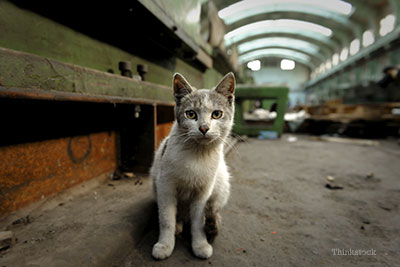
Whenever I see a feral cat, I see the wild, ancestral roots hiding just beneath the surface of every domestic cat. Even the wildest feral cat can be just one generation away from being someone’s pampered, household pet. Feral cats are victims of their own success as efficient hunters and prolific breeders. Although their exact numbers are unknown, the Humane Society of the United States estimates that there are about 50 million feral cats in this country. The problem is not unique to the United States. You are just as likely to find them on the beaches of Phuket or the ruins in Rome as you are in your own neighborhood. If you look carefully, you will see them everywhere. You can see them basking in the sun, hiding under cars, or rummaging through garbage cans in alleys. While feral cats can survive without human assistance, they live a harsh existence and often die prematurely from illness, injury or starvation.
So what is being done to help feral cats?
Unfortunately, there is no simple solution. In the United States, the majority of programs are trap-neuter-return (TNR) programs run by animal shelters and municipalities. These programs help control the feral cat population by humanely trapping feral cats, neutering/spaying them and then returning them to their environment or moving them to a designated location. Some programs will even rent or loan humane traps to the public in order to help trap and neuter/spay feral cats in their neighborhoods. How effective are these programs? Alleycat.org cites studies from the University of Florida and the University of Texas A&M, to contend that TNR programs reduce the overall feral cat population significantly and humanely.
How can you help feral cats?
Make sure your own cats are spayed and neutered so they are not contributing to the feral cat problem. Cats are prolific breeders and even someone’s pampered pet can result in another generation of feral cats. Besides being responsible for your own pets, support TNR programs financially. Monetary donations will not only fund operations to keep the program running, but also fund awareness campaigns to educate the public about the feral cat problem and how they can help. These programs also depend on volunteer support and you can help by volunteering your time with trap-neuter-release programs or their educational campaigns.
The problem of pet overpopulation is worldwide. While there is no simple solution, the first step toward tackling the global problem should start in your own backyard.
If you have any questions or concerns, you should always visit or call your veterinarian -- they are your best resource to ensure the health and well-being of your pets.
